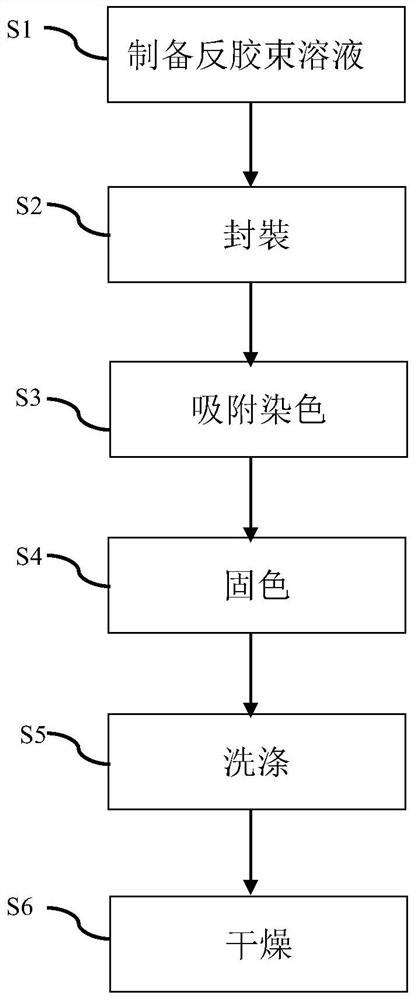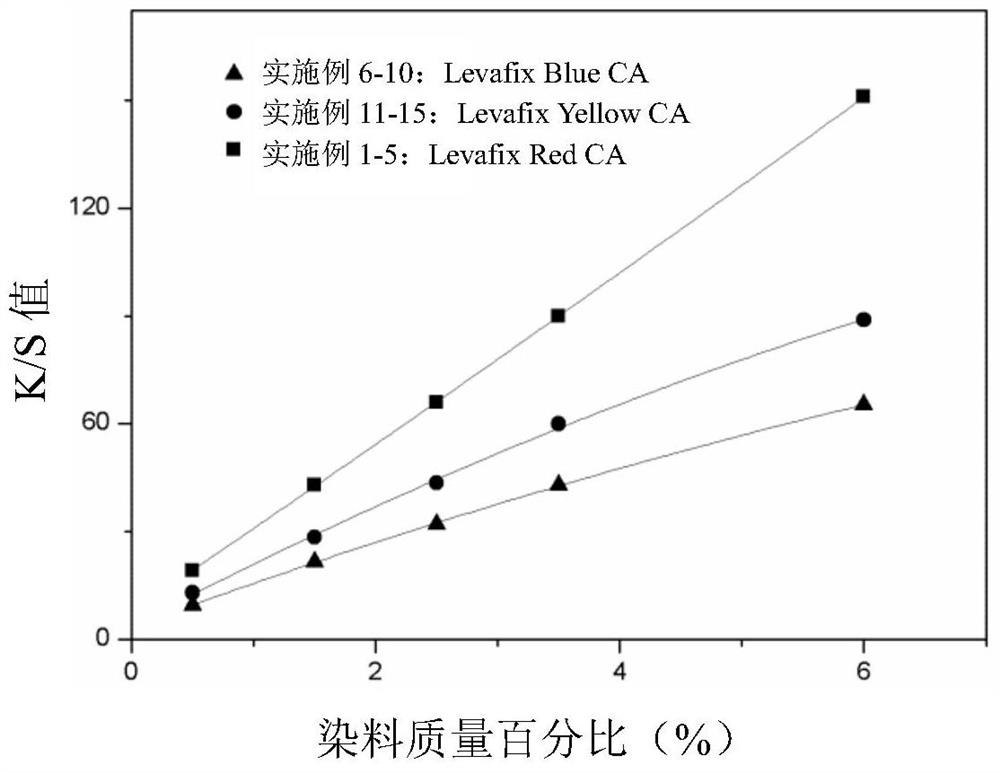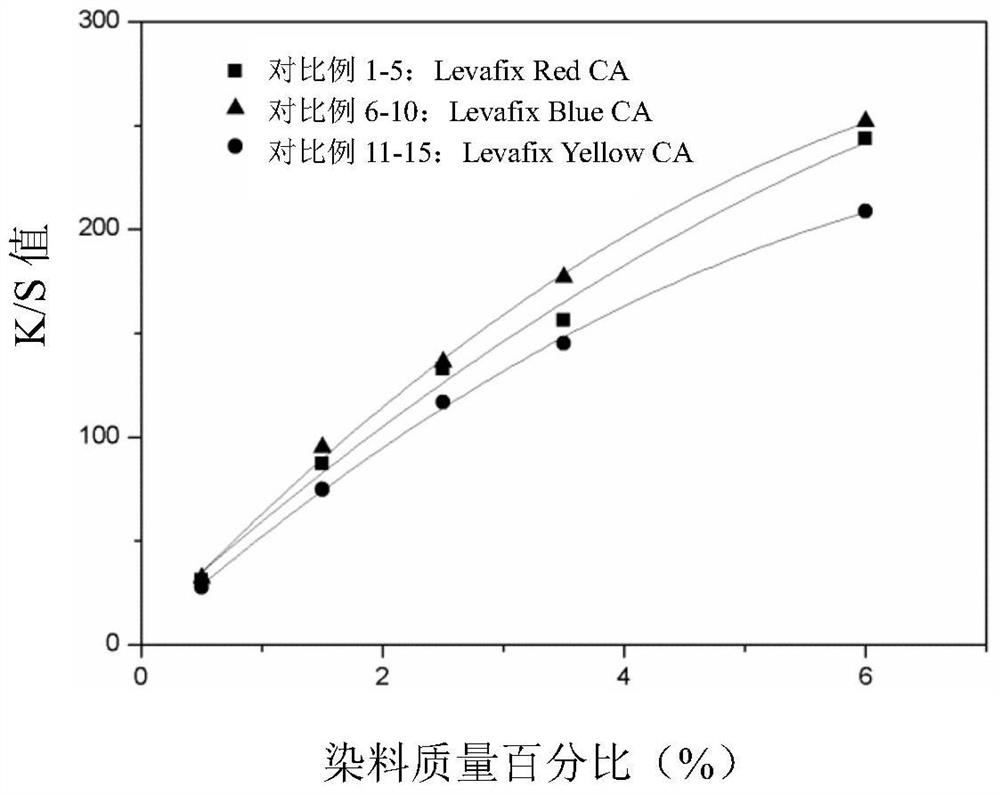A kind of fabric non-aqueous dyeing process
A process method and fabric technology, applied in the field of textiles, can solve the problems of poor dyeing effect, waste of raw materials, etc., and achieve the effects of energy saving, good dyeing effect and reduction of environmental pollution
- Summary
- Abstract
- Description
- Claims
- Application Information
AI Technical Summary
Problems solved by technology
Method used
Image
Examples
Embodiment 1
[0040] In this embodiment, the nonionic surfactant is polyethylene glycol-12-tridecyl ether, that is, R in the molecular formula 1 for H, R 2 for linear C 13 Alkyl, n is 12. At room temperature, pre-mix 0.0175mol of n-octanol and 0.0025mol of non-ionic surfactant in a beaker by stirring, the ratio is 7:1, and dissolve them in 15ml of n-octane after mixing to make reverse Micellar solution; a certain amount of Levafix Red CA reactive dye is dissolved in a very small amount of water to make 0.5ml of a reactive dye solution with a mass percentage of 5%, and the reactive dye solution is slowly injected into the reverse micellar solution. After vigorously stirring for 2 minutes at a rotating speed, the solution was clarified to obtain a reactive dye solution encapsulated in reverse micelles, wherein the mass ratio of the reactive dye to 1 gram of fabric was 2.5%; a sample of 1 g of cotton fabric was immersed in a ratio of 1:15 In the reactive dye liquid encapsulated by reverse m...
Embodiment 2
[0042] In this embodiment, the nonionic surfactant is polyethylene glycol-12-tridecyl ether, that is, R in the molecular formula 1 for H, R 2 for linear C 13 Alkyl, n is 12. At room temperature, pre-mix 0.0156mol of n-octanol and 0.0024mol of non-ionic surfactant in a beaker by stirring, the ratio is 6.5:1, and dissolve in 10ml of n-octane after mixing to make a reverse glue Beam solution; Dissolve a certain amount of Levafix Red CA reactive dye in a small amount of water to make 0.5ml of a reactive dye solution with a mass percentage of 7%. Slowly inject the reactive dye solution into the reverse micellar solution, and force it under 800rpm after injection. After stirring for 5 minutes, the solution was clarified to obtain a reactive dye solution encapsulated by reverse micelles, wherein the reactive dye was 3.5% by mass compared to 1 gram of fabric; In the reactive dye solution encapsulated by bundles, the container of the reactive dye solution encapsulated by the reverse...
Embodiment 3
[0044] In this embodiment, the nonionic surfactant is polyethylene glycol-12-tridecyl ether, that is, R in the molecular formula 1 for H, R 2 for linear C 13 Alkyl, n is 12. At room temperature, pre-mix 0.018mol of n-octanol and 0.0024mol of non-ionic surfactant in a beaker by stirring, the ratio is 7.5:1, mix and dissolve in 13ml of n-octane to make a reverse glue Beam solution; a certain amount of Levafix Red CA reactive dye is dissolved in a very small amount of water to make 0.5ml of a reactive dye solution with a mass percentage of 3%, and the reactive dye solution is slowly injected into the reverse micellar solution. After vigorously stirring for 5 minutes, the solution was clarified to obtain a reactive dye solution encapsulated by reverse micelles, wherein the reactive dye was 1.5% by mass compared to 1 gram of fabric; Immerse in the reactive dye solution encapsulated in reverse micelles, and vibrate the container filled with the reactive dye solution encapsulated ...
PUM
| Property | Measurement | Unit |
|---|---|---|
| concentration | aaaaa | aaaaa |
| concentration | aaaaa | aaaaa |
| concentration | aaaaa | aaaaa |
Abstract
Description
Claims
Application Information
 Login to View More
Login to View More - R&D
- Intellectual Property
- Life Sciences
- Materials
- Tech Scout
- Unparalleled Data Quality
- Higher Quality Content
- 60% Fewer Hallucinations
Browse by: Latest US Patents, China's latest patents, Technical Efficacy Thesaurus, Application Domain, Technology Topic, Popular Technical Reports.
© 2025 PatSnap. All rights reserved.Legal|Privacy policy|Modern Slavery Act Transparency Statement|Sitemap|About US| Contact US: help@patsnap.com



